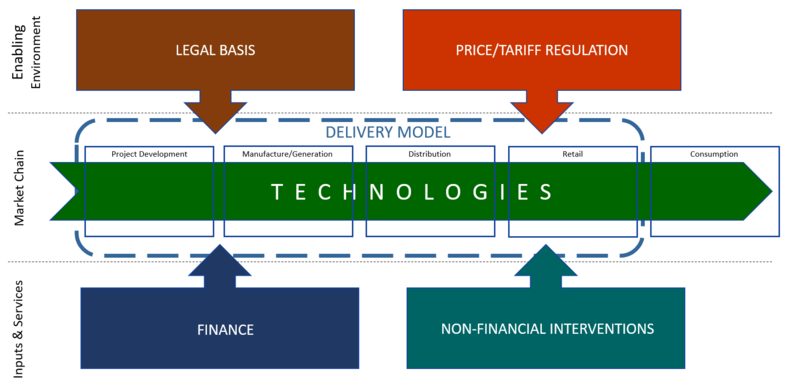Knowledge fuels change
For over a decade, Energypedia has shared free, reliable energy expertise with the world.
We’re now facing a serious funding gap.
Help keep this platform alive — your donation, big or small, truly matters!
Thank you for your support
National Approaches to Electrification – Review of Options
Category Dashboard:
![National Approaches to Electrification – Review of Options.png]]](/images/thumb/5/52/National_Approaches_to_Electrification_%E2%80%93_Review_of_Options.png/800px-National_Approaches_to_Electrification_%E2%80%93_Review_of_Options.png) |
Key Messages
- Categorization allows National Electrification Approaches to be presented and compared systematically
- NEAs combine technologies, delivery models, regulation, financial and other interventions – most effective approaches include actions in all these areas
- There is no one ideal approach to electrification. Successful NEA elements are well alighted with each otehr and national context
- NEA should change over time as levels of electrification increase
- Major advances in electrification can be achieved in just a few years given commitment from policy makers.
What are National Approches to Electrification (NAE)?
Definition
NAE are "An approach adopted by national authorities to increase electricity access in a country."
- NEA are based on and driven by government policies
- An initiative by a business or NGO alone will not qualify as an NEA
- Most NEA are based on explicit government policies and interventions, but a policy of non-intervention (eg a decision not to regulate) may also be part of an NEA
- NEA may consist of a multi-faceted programme combining policies, financing and interventions or just of a single policy or intervention
Boundaries
The purpose of this Option Review Tool is to support analysis of NEA and assist in identifying options and so improving NEA design.
A country may have more than one NEA and a critical first step is to set boundaries around the NEA:
- These need to be wide enough to include policies and interventions which interact
- But they need to be narrow enough to support meaningful analysis (impossible if every category of NEA activity is included)
There are no absolute rules, but some suggestions:
- Set time boundaries – Approaches change over time
- Consider looking at one technology or one type of delivery model at a time
- Are different approaches most relevant in different areas of the country (eg urban/rural or regions) or for different user groups (households, SMEs etc)?
- Do not split single, coherent, programmes designed to include multiple categories
- Set boundaries iteratively – aim to include 1(at most 2) types of technology, delivery model, legal basis and form of tariff regulation - and revise boundaries to optimise the balance between encompassing relevant aspects and ease of analysis.
How to Use this Tool
Downloading the Tool
- The tool is is available to download as a Powerpoint in full screen slide show:https://energypedia.info/images/a/aa/National_Approaches_to_Electrification_-_Review_of_Options.pptx
Categorization of National Approaches to Electrification
Categorization makes it possible to look at NEA on a systematic, country-neutral basis to understand and compare options.
Up to now, NEA have most frequently been categorized by:
- Technology or form of electrification eg grid, mini-grid or standalone
- Delivery model – generally government vs market or centralized vs decentralized
- Form of policy or intervention
These categorization systems address only a single aspect of the NEA. Different systems use inconsistent definitions and generally cover only one form of electrification (eg mini-grids, or pico-solar).
A new categorization system which encompasses all forms and aspects of NEA is needed.
Proposed Categorization Framework:
Technology |
Delivery Model |
Legual Basis |
Price/Tariff Regulation |
Finance |
Non-Financial Interventions |
The physical means by which electricity is generated, transmitted and distributed |
The (market) chain of organisations through which electricity is delivered to users |
The basis on which organisations are legally entitled to sell electricity |
The basis on which the price of electricity (or of standalone systems) are regulated |
Forms of funding used to finance electricity access |
Actions taken to support or facilitate electricity access |
Category Dashboard and Information on Categories
Example Table and Country Case Studies
- Bangladesh
- Brazil
- Cambodia
- Costa Rica
- Ethiopia
- Kenya
- Mali
- Nepal
- Peru
- Philippines
- Rwanda
- South Africa
- Tanzania
- Tunisia,Vietnam
Further Information
References
Authors
Authors: Mary Willcox, Dean Cooper
Acknowledgements
The Review was prepared by Mary Willcox and Dean Cooper of Practical Action Consulting working with Hadley Taylor, Silvia Cabriolu-Poddu and Christina Stuart of the EU Energy Initiative Partnership Dialogue Facility (EUEIPDF) and Michael Koeberlein and Caspar Priesemann of the Energising Development Programme (EnDev). It is based on a literature review, stakeholder consultations and development of the NEA categorization system used in the Review Tool.
A wider range of stakeholders were consulted during its preparation and we would particularly like to thank the following for their valuable contributions and insights:
- Jeff Felten, AfDB
- Marcus Wiemann and other members, ARE
- Guilherme Collares Pereira, EdP
- David Otieno Ochieng, EUEI-PDF
- Silvia Luisa Escudero Santos Ascarza, EUEI-PDF
- Nico Peterschmidt, Inensus
- John Tkacik, REEEP
- Khorommbi Bongwe, South Africa: Department of Energy
- Rashid Ali Abdallah, African Union Commission
- Nicola Bugatti, ECREEE
- Getahun Moges Kifle, Ethiopian Energy Authority
- Marion Merchan Andres, EUEI-PDF
- Tatjana Walter-Breidenstein, EUEI-PDF
- Rebecca Symington, Miland Foundation
- Marcel Reets, RVO NL
- Nico Tyabji, Sunfunder
Any feedback would be very welcome. If you have any comments or enquires please contact: Mary.Willcox@practicalaction.org.uk, hadley.taylor@euei-pdf.org, or michael.koeberlein@giz.de.





















